6 books about O'Brian, John
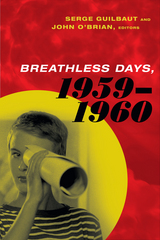
Breathless Days, 1959-1960
Serge Guilbaut and John O'Brien, editors
Duke University Press, 2017
Taking 1959–1960 as a pivotal cultural and political moment, the contributors to Breathless Days reframe postwar Western art history, examining the aesthetic and ideological alliances and tensions in art throughout Western Europe and the Americas. The collection provides a heterogeneous account of the intersections of the fine art world with literature, jazz, film, and theater in New York, Paris, Milan, Brazil, and Cuba. This reveals the knotty and multilayered connections among these divergent artistic milieus. Whether discussing Duchamp’s With My Tongue in My Cheek, Brazilian abstraction, postrevolutionary Cuban art, Jean Tinguely’s self-destroying machines, or Burroughs’s Naked Lunch, the contributors show this brief period to be a key to the cultural and political development of Western Europe and the Americas during the Cold War.
Contributors. Carla Benzan, Clint Burnham, Jill Carrick, Eric de Chassey, Mari Dumett, Serge Guilbaut, Luc Lang, Hadrien Laroche, Aleca Le Blanc, Richard Leeman, Tom McDonough, Regis Michel, John O'Brian, Kjetil Rodje, Ludovic Tournès, Antonio Eligio (Tonel)
[more]
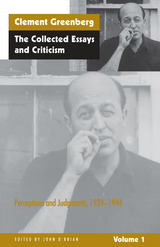
The Collected Essays and Criticism, Volume 1
Perceptions and Judgments, 1939-1944
Clement Greenberg
University of Chicago Press, 1988
Clement Greenberg (1909–1994), champion of abstract expressionism and modernism—of Pollock, Miró, and Matisse—has been esteemed by many as the greatest art critic of the second half of the twentieth century, and possibly the greatest art critic of all time. On radio and in print, Greenberg was the voice of "the new American painting," and a central figure in the postwar cultural history of the United States.
Greenberg first established his reputation writing for the Partisan Review, which he joined as an editor in 1940. He became art critic for the Nation in 1942, and was associate editor of Commentary from 1945 until 1957. His seminal essay, "Avant-Garde and Kitsch" set the terms for the ongoing debate about the relationship of modern high art to popular culture. Though many of his ideas have been challenged, Greenberg has influenced generations of critics, historians, and artists, and he remains influential to this day.
[more]
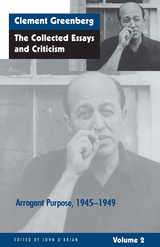
The Collected Essays and Criticism, Volume 2
Arrogant Purpose, 1945-1949
Clement Greenberg
University of Chicago Press, 1988
Clement Greenberg (1909–1994), champion of abstract expressionism and modernism—of Pollock, Miró, and Matisse—has been esteemed by many as the greatest art critic of the second half of the twentieth century, and possibly the greatest art critic of all time. On radio and in print, Greenberg was the voice of "the new American painting," and a central figure in the postwar cultural history of the United States.
Greenberg first established his reputation writing for the Partisan Review, which he joined as an editor in 1940. He became art critic for the Nation in 1942, and was associate editor of Commentary from 1945 until 1957. His seminal essay, "Avant-Garde and Kitsch" set the terms for the ongoing debate about the relationship of modern high art to popular culture. Though many of his ideas have been challenged, Greenberg has influenced generations of critics, historians, and artists, and he remains influential to this day.
[more]
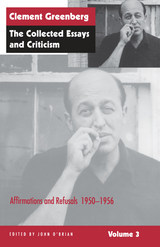
The Collected Essays and Criticism, Volume 3
Affirmations and Refusals, 1950-1956
Clement Greenberg
University of Chicago Press, 1995
Clement Greenberg is widely recognized as the most influential and articulate champion of modernism during its American ascendency after World War II, the period largely covered by these highly acclaimed volumes of The Collected Essays and Criticism. Volume 3: Affirmations and Refusals presents Greenberg's writings from the period between 1950 and 1956, while Volume 4: Modernism with a Vengeance gathers essays and criticism of the years 1957 to 1969. The 120 works range from little-known pieces originally appearing Vogue and Harper's Bazaar to such celebrated essays as "The Plight of Our Culture" (1953), "Modernist Painting" (1960), and "Post Painterly Abstraction" (1964). Preserved in their original form, these writings allow readers to witness the development and direction of Greenberg's criticism, from his advocacy of abstract expressionism to his enthusiasm for color-field painting.
With the inclusion of critical exchanges between Greenberg and F. R. Leavis, Fairfield Porter, Thomas B. Hess, Herbert Read, Max Kozloff, and Robert Goldwater, these volumes are essential sources in the ongoing debate over modern art. For each volume, John O'Brian has furnished an introduction, a selected bibliography, and a brief summary of events that places the criticism in its artistic and historical context.
With the inclusion of critical exchanges between Greenberg and F. R. Leavis, Fairfield Porter, Thomas B. Hess, Herbert Read, Max Kozloff, and Robert Goldwater, these volumes are essential sources in the ongoing debate over modern art. For each volume, John O'Brian has furnished an introduction, a selected bibliography, and a brief summary of events that places the criticism in its artistic and historical context.
[more]
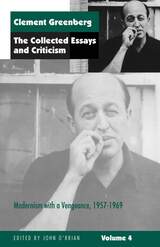
The Collected Essays and Criticism, Volume 4
Modernism with a Vengeance, 1957-1969
Clement Greenberg
University of Chicago Press, 1995
Clement Greenberg is widely recognized as the most influential and articulate champion of modernism during its American ascendency after World War II, the period largely covered by these highly acclaimed volumes of The Collected Essays and Criticism. Volume 3: Affirmations and Refusals presents Greenberg's writings from the period between 1950 and 1956, while Volume 4: Modernism with a Vengeance gathers essays and criticism of the years 1957 to 1969. The 120 works range from little-known pieces originally appearing Vogue and Harper's Bazaar to such celebrated essays as "The Plight of Our Culture" (1953), "Modernist Painting" (1960), and "Post Painterly Abstraction" (1964). Preserved in their original form, these writings allow readers to witness the development and direction of Greenberg's criticism, from his advocacy of abstract expressionism to his enthusiasm for color-field painting.
With the inclusion of critical exchanges between Greenberg and F. R. Leavis, Fairfield Porter, Thomas B. Hess, Herbert Read, Max Kozloff, and Robert Goldwater, these volumes are essential sources in the ongoing debate over modern art. For each volume, John O'Brian has furnished an introduction, a selected bibliography, and a brief summary of events that places the criticism in its artistic and historical context.
With the inclusion of critical exchanges between Greenberg and F. R. Leavis, Fairfield Porter, Thomas B. Hess, Herbert Read, Max Kozloff, and Robert Goldwater, these volumes are essential sources in the ongoing debate over modern art. For each volume, John O'Brian has furnished an introduction, a selected bibliography, and a brief summary of events that places the criticism in its artistic and historical context.
[more]
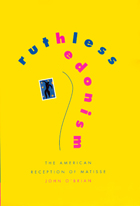
Ruthless Hedonism
The American Reception of Matisse
John O'Brian
University of Chicago Press, 1999
"Oh, do tell the American people that I am a normal man; that I am a devoted husband and father, that I have three fine children, that I go to the theatre." These words were spoken by Matisse just before the Armory Show in 1913—a pivotal moment, after which his work was seen in America as an example of what should be admired or deplored in modern art.
In this ambitious study, John O'Brian argues that Matisse's sober presentations of himself were calculated to fit with the social constraints and ideological demands of the times. Matisse's strategy included cooperating with museums, cultivating private collectors, playing off dealers one against another, and reassuring the media that, whatever his reputation as an avant-gardist, the conduct of his life was solidly bourgeois.
Moving from the late 1920s, when Matisse's output was shedding its outlaw reputation, to the early 1950s, when his work was canonized, O'Brian shows how the way Matisse's work was viewed changed as attention shifted away from the seductiveness of his subject matter to the seductiveness of his paint. The art's resolute rejection of political concerns, its deployment of decorative design for visual satisfaction, and its representations of pleasure encouraged American audiences, who in the 1930s deemed the art disreputable, to celebrate its gratifications by the early years of the Cold War.
This intriguing, wide-ranging investigation of Matisse's self-promotion, America's uneasy embrace of modernism, and America's consumer culture and politics provides a rich context to Clement Greenberg's words published in the Nation in 1947: "Matisse's cold hedonism and ruthless exclusion of everything but the concrete, immediate sensation will in the future, once we are away from the present Zeitgeist, be better understood as the most profound mood of the first half of the twentieth century."
In this ambitious study, John O'Brian argues that Matisse's sober presentations of himself were calculated to fit with the social constraints and ideological demands of the times. Matisse's strategy included cooperating with museums, cultivating private collectors, playing off dealers one against another, and reassuring the media that, whatever his reputation as an avant-gardist, the conduct of his life was solidly bourgeois.
Moving from the late 1920s, when Matisse's output was shedding its outlaw reputation, to the early 1950s, when his work was canonized, O'Brian shows how the way Matisse's work was viewed changed as attention shifted away from the seductiveness of his subject matter to the seductiveness of his paint. The art's resolute rejection of political concerns, its deployment of decorative design for visual satisfaction, and its representations of pleasure encouraged American audiences, who in the 1930s deemed the art disreputable, to celebrate its gratifications by the early years of the Cold War.
This intriguing, wide-ranging investigation of Matisse's self-promotion, America's uneasy embrace of modernism, and America's consumer culture and politics provides a rich context to Clement Greenberg's words published in the Nation in 1947: "Matisse's cold hedonism and ruthless exclusion of everything but the concrete, immediate sensation will in the future, once we are away from the present Zeitgeist, be better understood as the most profound mood of the first half of the twentieth century."
[more]
READERS
Browse our collection.
PUBLISHERS
See BiblioVault's publisher services.
STUDENT SERVICES
Files for college accessibility offices.
UChicago Accessibility Resources
home | accessibility | search | about | contact us
BiblioVault ® 2001 - 2024
The University of Chicago Press









